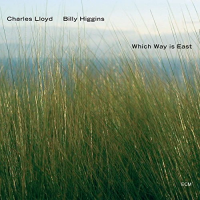Home » Jazz Articles » Album Review » Charles Lloyd/Billy Higgins: Which Way Is East
Charles Lloyd/Billy Higgins: Which Way Is East
Over the course of two discs, Lloyd and Higgins play seventeen duos. Lloyd plays six solo numbers, Higgins seven. Although known as a tenor man and flutist, Lloyd chooses to mark this occasion primarily on alto sax, on which he has seldom performed since the early ‘60s. He also plays piano, flutes, percussion, tenor sax and assorted woodwinds. Higgins plays not only drum set, but also wood box, hand drums, and multiple stringed instruments, including guitar. He sings, too. Not just sings—he cries out to his maker, in Arabic, Portuguese and English. On “Oh, Karim,” “Ya, Karim” and “My Lord, My Lord,” his guttural chants could lead one to believe the man was born in Tangiers. But just a few tracks later, on “Blues Tinge,” his guitar and vocals are pure Mississippi front porch. Here, Higgins reveals a side of himself—the straight-ahead jazz drummer as multi-instrumentalist, singer and even songwriter—that very few had known about.
Which Way Is East is divided into eight suites (four suites per disc), each consisting of anywhere from three to five movements. When Lloyd and Higgins go toe to toe on alto sax and traps, the result is unadulterated free jazz. Lloyd’s horn speaks in the tongues of Bird, Ornette and even Dolphy. His four solo piano pieces bring to mind his frequent label mate Paul Bley. His flutes (alto on “Akhi,” bass on “Sally Sunflower Whitecloud”) conjure a wondrous, California-woods solitude. His taragato and Tibetan oboe speak of a worldly spirituality that is right in line with Higgins’. (Lloyd is a student of Vedanta, Higgins was a convert to Islam.) But Lloyd also brings it all back to the blues, in the spirit of Sonny and Trane, on “Windy Mountain.”
Lloyd is slated to give a series of unaccompanied concerts during the course of this year. Who can doubt that when he does, he will be hearing the sounds of Higgins? “I didn’t say I would be there, but I will always be with you,” Higgins tells Lloyd in the moving tête-à-tête that serves as this album’s liner notes. “You talkin’ ‘bout the journey’s end—the journey’s just beginning.”
Visit ECM Records on the web.
Track Listing
CD 1: What Is Man; Divans; Salaam; All This Is That.
CD 2: Desire; Devotion; Light of Love; Surrender.
Personnel
Charles Lloyd
saxophoneBilly Higgins
drumsCharles Lloyd (tenor and alto saxophones, bass, alto and C flutes, piano, taragato, Tibetan oboe, percussion, maracas, voice), Billy Higgins (drums, guitar, guimbri, Syrian ?one string,? Senegalese, Guinean and Indian hand drums, Juno?s Wood box, percussion, voice)
Album information
Title: Which Way Is East | Year Released: 2004 | Record Label: ECM Records
< Previous
The Outernational Sound
Next >
Ynde
Comments
About Charles Lloyd
Instrument: Saxophone
Related Articles | Concerts | Albums | Photos | Similar ToTags
For the Love of Jazz
 All About Jazz has been a pillar of jazz since 1995, championing it as an art form and, more importantly, supporting the musicians who create it. Our enduring commitment has made "AAJ" one of the most culturally important websites of its kind, read by hundreds of thousands of fans, musicians and industry figures every month.
All About Jazz has been a pillar of jazz since 1995, championing it as an art form and, more importantly, supporting the musicians who create it. Our enduring commitment has made "AAJ" one of the most culturally important websites of its kind, read by hundreds of thousands of fans, musicians and industry figures every month.





















